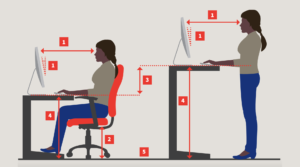Neck pain is an exceedingly common affliction, affecting up to two-thirds of adults at some point in their lives. Its prevalence underscores the disruptive role neck pain can play in our daily activities. Even simple motions like turning the head or looking downward can become unbearable with sudden, acute neck pain.
Persistent, chronic neck pain may be duller but can prove even more detrimental over time.
The causes of neck pain are multifold, ranging from obvious trauma and injury to more insidious culprits like poor posture and repetitive stress. Acute neck pain usually stems from damage to the cervical vertebrae and surrounding muscles, often from accidents or strains. Chronic neck pain often arises gradually due to accumulated inflammation, irritated nerves, or degenerative disc disease. Emotional stress and mental exhaustion can also manifest physically as neck tension.
Regardless of its source, neck pain takes considerable physical and emotional toll. Chronic neck pain in particular can impact mood, energy levels, and quality of life. The constant discomfort makes it difficult to focus on work, enjoy hobbies, and fully engage in life. Even sleep may suffer when neck pain prevents restful postures. This ever-present pain understandably contributes to anxiety, irritability, and depression. Proper treatment is crucial to alleviate the burden of debilitating neck pain.
Want to study more. Here is an example link to a study more on neck pain prevalence from the National Institutes of Health and an APA article on the emotional impact of chronic pain:
Understanding Neck Pain Causes
Our necks are intricate structures, allowing us to move our heads with ease. However, sometimes they can become stiff and painful, making even simple movements like turning your head feel like a chore. This discomfort can arise from various reasons, just like a car malfunctioning due to different issues. Let’s delve deeper into some common culprits behind neck pain:
1. Muscle Strain: Like any other muscle in your body, the ones in your neck can become strained from overuse or awkward positions. This can happen from:
- Maintaining a fixed head position for extended periods: This is a common issue for people who work at desks or use their phones extensively. Holding your head down while looking at your screen puts continuous strain on your neck muscles.
- Carrying heavy bags unevenly: This can lead to muscle imbalance and strain on one side of your neck.
- Sleeping in an uncomfortable position: An unsupportive pillow or mattress can force your neck into an unnatural position throughout the night, leading to stiffness and pain upon waking.
2. Injuries: Sudden accidents or injuries can damage the muscles, ligaments, or bones in your neck. Examples include:
- Whiplash: This is a common injury caused by a sudden jolt to the head, often occurring during car accidents. It can cause pain, stiffness, and dizziness.
- Sports injuries: Contact sports like football or rugby can put your neck at risk of injury from falls, tackles, or collisions.
- Falls: A fall, especially on your head or back, can damage the bones or soft tissues in your neck.
3. Arthritis: This is a condition where the cartilage in your joints breaks down, causing inflammation, pain, and stiffness. It can affect the joints in your spine, including those in your neck.
4. Poor Posture: Slouching or hunching over for long periods can put excessive strain on your neck muscles, leading to pain, stiffness, and even headaches. This is especially common in individuals who work at desks or spend a lot of time looking down at their phones.
5. Herniated Disc: The discs between your vertebrae act like cushions, absorbing shock and allowing for smooth movement. Sometimes, the soft inner part of the disc can push through the tougher outer layer, putting pressure on nearby nerves and causing pain, numbness, or weakness in your neck and arm.
This list is not exhaustive, and it’s crucial to consult a doctor or healthcare professional if you experience persistent neck pain. They can help you determine the underlying cause and recommend the most appropriate treatment plan for your specific situation.
- Learn more about common neck pain causes:
Unveiling the Cause of Your Neck Pain
Neck pain can be a real drag, leaving you feeling stiff and uncomfortable. But before you jump to conclusions, it’s important to understand the source of the problem. Fortunately, diagnosing neck pain often involves a straightforward process, and in most cases, it doesn’t require elaborate or scary tests. Let’s explore the steps involved in getting the culprit behind your neck pain identified:
1. The Initial Chat: Gathering Clues
Your journey towards a diagnosis usually begins with a chat with a healthcare professional, like a doctor or physical therapist. During this conversation, they’ll become detectives, piecing together the puzzle of your pain. They’ll ask questions like:
- “Describe the pain detective, anything unusual?”: This includes the kind of pain, its intensity, location, and any other companions it brings, like headaches or weakness.
- “Tell me your story”: Sharing your medical history helps them identify potential culprits, like old injuries or existing conditions.
- “What’s a typical day for you?”: Discussing your daily routine, work environment, and posture can provide hidden clues about what might be contributing to your discomfort.
2. The Physical Examination: Putting Your Neck to the Test
Following the initial conversation, a physical examination is usually conducted to assess your range of motion, tenderness, and any other abnormalities in your neck and surrounding areas. Imagine a gentle detective examining the scene of the crime, but instead of fingerprints, they’re looking for:
- Posture patrol: The healthcare professional will observe your posture while standing and sitting, searching for any imbalances or misalignments.
- Tenderness check: They’ll gently feel your neck muscles to identify any areas of pain, tightness, or spasms.
- Range of motion test: This involves assessing the movement of your neck in different directions, like trying to touch your chin to your chest or turning your head to see what’s behind you.
- Checking for nerve involvement: This might involve testing your reflexes, sensation, and muscle strength in your arms and hands to rule out any pinched nerves.
3. Imaging Tests (When Necessary): Seeing What’s Hidden
In most cases, the physical examination is enough to identify the cause of neck pain. However, sometimes additional tools are needed, like imaging tests. These act like X-ray vision, allowing the doctor to see inside your neck and identify potential causes like:
- X-rays: These provide basic pictures of your bones, helpful for detecting fractures or misalignments.
- MRI scans: These create detailed images of your bones, muscles, and nerves, offering a more comprehensive view of the structures in your neck.
- CT scans: Similar to MRIs, these provide detailed cross-sectional images but use X-rays instead of magnetic fields.
Remember, seeking professional help is crucial!
While this section provides a general overview of the diagnostic process, it’s not a substitute for professional medical advice. If you’re experiencing persistent or severe neck pain, consulting a healthcare professional is essential. They can provide a proper diagnosis, identify any underlying conditions, and recommend the best treatment plan to get you back to feeling your best.
Learn more about the diagnostic process for neck pain: American Academy of Orthopaedic Surgeons
Find information on specific imaging tests (e.g., X-ray, MRI): American College of Radiology
Taming the Nagging Nuisance: Managing and Relieving Neck Pain
Neck pain, a frequent companion of our modern lives, can be a real drag. It can put a damper on simple activities like turning your head or enjoying a good night’s sleep. But fear not, fellow warriors against discomfort! There are ways to manage and even relieve this pesky problem. Let’s explore some strategies to help you reclaim your neck’s freedom:
1. Self-Care Strategies: Your First Line of Defense
Think of self-care as your personal toolbox against neck pain. Here are some handy tools to keep in there:
- Heat and Ice Therapy: Applying heat with a heating pad or warm compress can relax tight muscles, while ice packs can help reduce inflammation.
- Gentle Stretches: Regular neck stretches can improve flexibility and range of motion, easing stiffness and discomfort. Remember, gentle is the keyword here!
- Over-the-counter pain medication: Pain relievers like ibuprofen or acetaminophen can offer temporary relief from mild to moderate pain.
2. Physical Therapy: Professional Guidance for Long-Term Relief
Physical therapists are the neck pain ninjas. They can assess your specific condition and design a personalized exercise program to strengthen the muscles supporting your neck, improve posture, and increase flexibility. Consider them your personal coach in the fight against neck pain.
3. Lifestyle Modifications: Small Changes, Big Impact
Sometimes, small tweaks to your daily routine can make a significant difference. Here are a few lifestyle modifications to consider:
- Maintain good posture: Whether sitting at your desk or standing tall, proper posture is key. Imagine a string pulling you up from the crown of your head, keeping your spine aligned.
- Ergonomics: Make sure your workspace is ergonomically designed to minimize strain on your neck. This may involve adjusting your chair height, using a monitor stand, or taking frequent breaks to move around.
- Manage stress: Stress can manifest in physical ways, including neck pain. Techniques like meditation, yoga, or deep breathing can help manage stress and potentially reduce its impact on your neck.
Remember: While these strategies can be helpful, it’s crucial to consult a healthcare professional if your neck pain is severe, persistent, or accompanied by other concerning symptoms. They can help identify the underlying cause and recommend the most appropriate treatment plan for you.
Additional Resources:
- Learn more about self-care strategies for neck pain:
Taking Control of Your Neck Pain
Throughout this journey, we’ve explored the various causes of neck pain, delving into its potential origins like awkward postures or even old injuries. We’ve also discovered an arsenal of tools to combat this discomfort, from self-care strategies like heat therapy and gentle stretches to seeking professional guidance from physical therapists.
Remember, understanding the root cause of your neck pain is crucial for achieving long-term relief. Addressing underlying issues and improving your posture are key components in preventing future flare-ups. But it’s important to acknowledge that sometimes, professional help is necessary.
If your neck pain is persistent, severe, or accompanied by other concerning symptoms, consulting a healthcare professional is vital. They can provide a proper diagnosis, identify any underlying conditions, and recommend the most appropriate treatment plan for your specific situation.
While this guide equips you with valuable information, remember that it’s not a substitute for professional medical advice. However, as you embark on your journey towards neck pain relief, consider exploring resources like FlexifyMe.FlexifyMe offers a unique approach to managing neck pain by combining certified trainers and physiotherapists with cutting-edge technology. Their personalized guidance and real-time posture correction can empower you to take control of your neck pain and prevent future occurrences. Remember, consistent effort and addressing the root cause are key to achieving lasting relief. So, take charge and explore the different options available to find the solution that works best for you.


